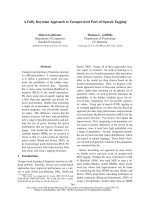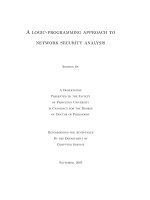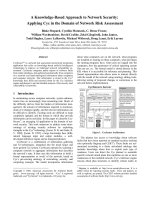A linear prediction approach to dimensional spectral factorization and spectral estimation
Bạn đang xem bản rút gọn của tài liệu. Xem và tải ngay bản đầy đủ của tài liệu tại đây (5.88 MB, 185 trang )
A LINEAR PREDICTION APPROACH TO TWO-DIMENSIONAL
SPECTRAL FACTORIZATION AND
SPECTRAL ESTIMATION
by
THOMAS LOUIS MARZETTA
S.B., Massachusetts Institute of Technology
(1972)
M.S., University of Pennsylvania
(1973)
SUBMITTED IN PARTIAL FULFILLMENT
OF THE REQUIREMENTS FOR THE
DEGREE OF
DOCTOR OF PHILOSOPHY
at the
MASSACHUSETTS INSTITUTE OF TECHNOLOGY
February, 1978
Signature of Author
Department of Electrical Engineering and
Computer Science, February 3, 1978
Certified by ..
Thesis Supervisor
Accepted by .
Chairman, Departmental Committee
Graduate Students
ARCHIVES
Ton
MAY 15 1978
_____
0ro
7
A LINEAR PREDICTION APPROACH TO TWO-DIMENSIONAL
SPECTRAL FACTORIZATION AND
SPECTRAL ESTIMATION
by
THOMAS LOUIS MARZETTA
Submitted to the Department of Electrical Engineering
and Computer Science on February 3, 1978, in partial fulfillment of the requirements for the degree of Doctor of
Philosophy.
Abstract
This thesis is concerned with the extension of the
theory and computational techniques of time-series linear
prediction to two-dimensional (2-D) random processes.
2-D random processes are encountered in image processing,
array processing, and generally wherever data is spatially
dependent. The fundamental problem of linear prediction is
to determine a causal and causally invertible (minimumphase), linear, shift-invariant whitening filter for a
given random process. In some cases, the exact power density
spectrum of the process is known (or is assumed to be known)
and finding the minimum-phase whitening filter is a deterministic problem. In other cases, only a finite set of
samples from the random process is available, and the
minimum-phase whitening filter must be estimated. Some
potential applications of 2-D linear prediction are Wiener
filtering, the design of recursive digital filters, highresolution spectral estimation, and linear predictive coding
of images.
2-D linear prediction has been an active area of
research in recent years, but very little progress has been
made on the problem. The principal difficulty has been the
lack of computationally useful ways to represent 2-D
minimum-phase filters.
In this thesis research, a general theory of 2-D
linear prediction has been developed. The theory is based
on a particular definition for 2-D causality which totally
orders the points in the plane. By paying strict attention
to the ordering property, all of the major results of 1-D
linear prediction theory are extended to the 2-D case.
Among other things, a particular class of 2-D,
least-squares, linear, prediction error filters are shown
to be minimum-phase, a 2-D version of the Levinson algorithm
is derived, and a very simple interpretation for the failure
of Shanks' conjecture is obtained.
From a practical standpoint, the most important
result of this thesis is a new canonical representation for
2-D minimum-phase filters. The representation is an extension of the reflection coefficient (or partial correlation coefficient) representation for 1-D minimum-phase filters
to the 2-D case. It is shown that associated with any 2-D
minimum-phase filter, analytic in some neighborhood of
the unit circles, is a generally infinite 2-D sequence of
numbers, called reflection coefficients, whose magnitudes
are less than one, and which decay exponentially to zero
away from the origin. Conversely, associated with any such
2-D reflection coefficient sequence is a unique 2-D
minimum-phase filter. The 2-D reflection coefficient representation is the basis for a new approach to 2-D linear
prediction. An approximate whitening filter is designed
in the reflection coefficient domain, by representing it
in terms of a finite number of reflection coefficients.
The difficult minimum-phase requirement is automatically
satisfied if the reflection coefficient magnitudes are
constrained to be less than one.
A remaining question is how to choose the reflection
coefficients optimally; this question has only been partially
addressed. Attention was directed towards one convenient,
but generally suboptimal method in which the reflection
coefficients are chosen sequentially in a finite raster scan
fashion according to a least-squares prediction error
criterion. Numerical results are presented for this approach as applied to the spectral factorization problem.
The numerical results indicate that, while this suboptimal,
sequential algorithm may be useful in some cases, more
sophisticated algorithms for choosing the reflection coefficients must be developed if the full potential of the
2-D reflection coefficient representation is to be realized.
Thesis Supervisor:
Title:
Arthur B. Baggeroer
Associate Professor of Electrical
Engineering
Associate Professor of Ocean Engineering
ACKNOWLEDGMENTS
I would like to take this opportunity to express my
appreciation to my thesis advisor, Professor Arthur Baggeroer,
and to my thesis readers, Professor James McClellan and
Professor Alan Willsky.
This research could not have been
performed without their cooperation.
It was Professor Baggeroer
who originally suggested that I investigate this research
topic; throughout the course of the research he maintained
the utmost confidence that I would succeed in shedding light
on what proved to be a difficult problem area.
I had many
useful discussions with Professor Willsky during the earlier
stages of the research.
Special thanks go to
Professor McClellan who was my unofficial thesis advisor
during Professor Baggeroer's sabbatical.
The daily contact and technical discussions with
Mr. Richard Kline and Dr. Kenneth Theriault were an indispensable part of my graduate education.
I would like to thank Mr. Dave Harris for donating his
programming skills to obtain the contour plot and the projection plot displayed in this thesis.
Finally, I must mention
the superb typing skills of Ms. Joanne Klotz.
This research was supported, in part, by a Vinton
Hayes Graduate Fellowship in Communications.
TABLE OF CONTENTS
Page
Title Page . .
. .
. . .
Abstract . ...
. ..
Acknowledgments
. . . .
. ..
. .
. .
. . . .
. . . . . .
••
. . . . .
.
. . .
. . .
. .
.
INTRODUCTION . .
. . .
. .
.
Table of Contents
CHAPTER 1:
. .
. .
..
•
.
2
.
1.1 One-dimensional Linear Prediction . . . . .
1.2 Two-dimensional Linear Prediction . . . . .
1.3 Two-dimensional Causal Filters . . . . . .
1.4 Two-dimensional Spectral Factorization and
Autoregressive Model Fitting . . . . . . .
1.5 New Results in 2-D Linear Prediction Theory
1.6 Preview of Remaining Chapters . . . . . . .
CHAPTER 2:
7
7
9
S. 11
13
16
23
SURVEY OF ONE-DIMENSIONAL LINEAR
PREDICTION . . . . . . . . . . . . . .
2.1 1-D Linear Prediction Theory . .
2.2 1-D Spectral Factorization . . .
2.3 1-D Autoregressive Model Fitting
CHAPTER 3:
. .
. .
. . .
. . .
TWO-DIMENSIONAL LINEAR PREDICTIONBACKGROUND . . . . . . . . . . . .
. .
24
33
35
. .
3.1 2-D Random Processes and Linear Prediction
3.2 Two-dimensional Causality . . . . . . . . .
3.3 The 2-D Minimum-phase Condition . . . . . .
3.4 Properties of 2-D Minimum-phase Whitening
Filters . . . . . . . . . . . . . . . . . .
3.5 2-D Spectral Factorization . . . . . . . . . .
3.6 Applications of 2-D Linear Prediction . . .
40
40
40
42
46
49
60
Page
CHAPTER 4:
NEW RESULTS IN 2-D LINEAR
PREDICTION THEORY
. . . . .
. .
. . .
. .
4.1 The Correspondence between 2-D Positivedefinite Analytic Autocorrelation Sequences
and 2-D Analytic Minimum-phase PEFs ...
. . .
4.2 A Canonical Representation for 2-D Analytic
Minimum-phase Filters . .....
....... .
4.3 The Behavior of the PEF HN,M(zl,z2) for
Large Values of N . . . . . . . . . . . . . . .
APPENDIX Al:
PROOF OF THEOREM 4.1 .
A1.1 Proof of Theorem 4.1(a) for
A1.2 Proof of Theorem 4.1(a) for
A1.3 Proof of Theorem 4.1(b) for
A1.4 Proof of Theorem 4.1(b) for
APPENDIX A2:
. .
. . .
. . .
66
66
77
90
.
94
HN-l,+m(zl,z 2 ) . .
HNM(zl,z 2 ) . . . .
94
101
HN-l,+m(z1
HNM(zl,z
111
114
PROOF OF THEOREM 4.3 .
. .
.
,Z 2 )
2
.
) . . . .
. . .
. . .
119
A2.1 Proof of Existence Part of Theorem 4.3(a) . .
A2.2 Proof of Uniqueness Part of Theorem
4.3(a) . . . . . . . . . . . . . . . . . . . .
A2.3 Proof of Existence Part of Theorem 4.3(b) . .
A2.4 Proof of Uniqueness Part of Theorem
4.3(b) . . . . . . . . . . . . . . . . . . . .
119
CHAPTER 5:
THE DESIGN OF 2-D MINIMUM-PHASE
WHITENING FILTERS IN THE RELFECTION
COEFFICIENT DOMAIN
. . . . . . . . .
134
136
141
.
148
5.1 Equations Relating the Filter to the
Reflection Coefficients ............
.
5.2 A 2-D Spectral Factorization Algorithm . ...
5.3 A 2-D Autoregressive Model Fitting Algorithm .
150
157
CHAPTER 6:
CONCLUSIONS AND SUGGESTIONS FOR FUTURE
RESEARCH. ......
. .
.. . . ....
References . . . . . .. . . . . . . . . . . . ..
.
174
181
183
CHAPTER 1
INTRODUCT ION
1.1
One-dimensional Linear Prediction
An important tool in stationary time-series analysis
is linear prediction.
The basic problem in linear predic-
tion is to determine a causal and causally invertible linear
shift-invariant filter that whitens a particular random
process.
The term "linear prediction" is used because if
a causal and causally invertible whitening filter exists,
it can be shown to be proportional to the least-squares
linear prediction error filter for the present value
of the process given the infinite past.
Linear prediction is an essential aspect of a
number of different problems including the Wiener filtering problem [1], the problem of designing a stable recursive
filter having a prescribed magnitude frequency response [2],
the autoregressive (or "maximum entropy") method of spectral
estimation [3], and the compression of speech by linear
predictive coding [4].
The theory of linear prediction
has been applied to the discrete-time Kalman filtering
problem (for the case of a stationary signal and noise)
to obtain a fast algorithm for solving for the timevarying gain matrix [5].
Linear prediction is closely
related to the problem of solving the wave-equation in a
nonuniform
transmission
line [6],
[7].
In general there are two classes of linear prediction problems.
In one case we are given the actual power
density spectrum of the process, and the problem is to
compute (or at least to find an approximation to) the
causal and causally invertible whitening filter.
We
refer to this problem as the spectral factorization problem.
The classical method of time-series spectral factorization (which is applicable whenever the spectrum is rational
and has no poles or zeroes on the unit circle) involves
first computing the poles and zeroes of the spectrum,
and then representing the whitening filter in terms of the
poles and zeroes located inside the unit circle [1].
In the second class of linear prediction problems
we are given a finite set of samples from the random
process, and we want to estimate the causal and causally
invertible whitening filter.
A considerable amount of
research has been devoted to this problem for the special
case where the whitening filter is modeled as a finiteduration impulse response (FIR) filter.
We refer to this
problem as the autoregressive model fitting problem.
In
the literature, this is sometimes called all-pole modeling.
(A more general problem is concerned with fitting a
rational whitening filter model to the data; this is called
autoregressive moving-average or pole-zero modeling.
Pole-zero modeling has received comparatively little
attention in the literature.
This is apparently due to
the fact that there are no computational techniques for
pole-zero modeling which are as effective or as convenient
to use as the available methods of all-pole modeling.)
The two requirements in autoregressive model fitting are
that the FIR filter should closely represent the secondorder statistics of the data, and that it should have a
causal, stable inverse.
(Equivalently, the zeroes of
the filter should be inside the unit circle.)
The two
most popular methods of autoregressive model fitting are
the so-called autocorrelation method [3] and the Burg algorithm [3].
Both algorithms are convenient to use, they
tend to give good whitening filter estimates, and under
certain conditions (which are nearly always attained in
practice) the whitening filter estimates are causally
invertible.
1.2
Two-dimensional Linear Prediction
Given the success of linear prediction in time-
series analysis, it would be desirable to extend it to
the analysis of multidimensional random processes, that is,
processes parameterized by more than one variable.
Multi-
dimensional random processes (also called random fields)
occur in image processing as well as radar, sonar, geophysical signal processing, and in general, in any situation
where data is sampled spatially.
In this thesis we will be working with the class
of two-dimensional (2-D) wide-sense stationary, scalarvalued random processes, denoted x(k,Z) where k and k
are integers.
The basic 2-D linear prediction problem is
similar to the 1-D problem:
for a particular 2-D process,
determine a causal and causally invertible linear shiftinvariant whitening filter.
While many results in 1-D random process theory are
easily extended to the 2-D case, the theory of 1-D linear
prediction has been extremely difficult, if not impossible,
to extend to the 2-D case.
Despite the efforts of many
researchers, very little progress has been made towards
developing a useful theory of 2-D linear prediction.
What
has been lacking is a computationally useful way to represent
2-D causal and causally invertible filters.
Our contribution in this thesis is to extend
virtually all of the known 1-D linear prediction theory
to the 2-D case.
We succeed in this by paying strict
attention to the ordering properties of points in the plane.
From a practical standpoint, our most important
result is a new canonical representation for 2-D causal
and causally invertible linear, shift-invariant filters.
We use this representation as the basis for new algorithms for 2-D spectral factorization and autoregressive
model fitting.
1.3
Two-dimensional Causal Filters
We define a 2-D causal, linear, shift-invariant
filter to be one whose unit sample response has the support illustrated in Fig. 1.1.
(In the literature, such
filters have been called "one-sided filters" and "nonsymmetric half-plane filters," and the term "causal filter"
has usually been reserved for the less-general class of
quarter-plane filters.
But there is no universally accepted
terminology, and throughout this thesis we use our own
carefully defined terminology.)
The motivation for
this definition of 2-D causality is that it leads to significant theoretical and practical results.
We emphasize
that the usefulness of the definition is independent of
any physical properties of the 2-D random process under
consideration.
This same statement also applies, although
to a lesser extent, to the 1-D notion of causality; often
a 1-D causal recursive digital filter is used, not because
its structure conforms to a physical notion of causality,
but because of the computational efficiency of the
recursive structure.
The intuitive idea of a causal filter is that
the output of the filter at any point should only depend
on the present and past values of the input.
Equivalently
the unit sample response of the filter must vanish at all
points occurring in the past of the origin.
Corresponding
to our definition of 2-D causality is the definition of
12
k
Fig. 1.1
Support for the unit sample response of a 2-D
causal filter.
13
"past," "present," and "future" illustrated in Fig. 1.2
This definition of "past," "present," and "future" uniquely
orders the points in the 2-D plane, the ordering being
in the form of an infinite raster scan.
It is this "total
ordering" property that makes our definition of 2-D
causality a useful one.
1.4
Two-dimensional Spectral Factorization and
Autoregressive Model Fitting
As in the 1-D case, the primary 2-D linear prediction
problems are 1) The determination (or approximation) of
the 2-D causal and causally invertible whitening filter
given the power density spectrum (spectral factorization);
and 2) The estimation of the 2-D causal and causally invertible
whitening filter given a finite set of samples from the
random process (for an FIR whitening filter estimate, the
autoregressive model fitting problem).
Despite the
efforts of many researchers, most of the theory and computational techniques of 1-D linear prediction have not been
extended to the 2-D case.
Considering the spectral factorization problem,
the 1-D method of factoring a rational spectrum by computing its poles and zeroes does not extend to the 2-D
case [8],
[9].
Specifically, a rational 2-D spectrum
almost never has a rational factorization (though under
certain conditions it does have an infinite-order
14
k
Fig. 1.2
Associated with any point (s,t) is a unique
"past" and "future."
15
factorization).
The implication of this is that in most
cases we can only approximately factor a 2-D spectrum.
Shanks proposed an approximate method of 2-D
spectral factorization which involves computing a finiteorder least-squares linear prediction error filter [10].
Unfortunately, Shanks method, unlike an analogous 1-D
method, does not always produce a causally invertible
whitening filter approximation [11].
Probably the most successful method of 2-D spectral
factorization to be proposed,is the Hilbert transform method
(sometimes called the cepstral method or the homomorphic
transformation method [8],
[12],
[13],
[14]). The method
relies on the fact that the phase and the log-magnitude of
a 2-D causal and causally invertible filter are 2-D Hilbert
transformpairs. While the method is theoretically exact,
it can only be implemented approximately, and it has some
practical difficulties.
Considering the autoregressive model fitting problem, neither the autocorrelation method nor the Burg algorithm
has been successfully extended to the 2-D case.
The 2-D auto-
correlation method fails for the same reason that Shanks
method fails.
The Burg algorithm is essentially a
stochastic version of the Levinson algorithm, which was
originally derived as a fast method of inverting a
Toeplitz covariance matrix [15].
Until now, no one has
discovered a 2-D version of the Levinson algorithm that
would enable a 2-D Burg algorithm to be devised.
1.5
New Results in 2-D Linear Prediction Theory
In this thesis we consider a special class of 2-D
causal, linear, shift-invariant filters that has not
previously been studied.
The form of this class of filters
It can be seen that these
is llustrated in Fig. 1.3.
filters are infinite-order in one variable, and finiteorder in the other variable.
Of greater significance
is the fact that according to our definition of 2-D
causality, the support for the unit sample response of these
filters consists of the points (0,0) and (N,M), and all
points in the future of (0,0) and in the past of (N,M).
The basic theoretical result of this thesis is that by
working with 2-D filters of this type, we can extend
virtually all of the known 1-D linear prediction theory to
the 2-D case.
1)
Among other things we can prove the following:
Given a 2-D, rational power density spectrum, S(zl,z 2 ),
which is strictly positive and bounded on the unit circles,
we can find a causal whitening filter for the random
process which is a ratio of two filters, each of the form
illustrated in Fig. 1.3.
Both the numerator and the
denominator polynomials of the whitening filter are analytic
in the neighborhood of the unit circles (so the filters
(N, M)
k
Fig. 1.3
A particular class of 2-D causal filters. The
support consists of the points (0,0), (N,M),
and all points in the future of (0,0) and in the
past of (N,M).
18
are stable), and they have causal, analytic inverses (so
the inverse filters are stable).
2) Consider the 2-D prediction problem illustrated in
Fig. 1.4.
The problem is to find the least-squares linear
estimate for the point x(s,t) given the points shown in
the shaded region.
The solution of this problem involves
solving an infinite set of linear equations.
This problem
is the same as that considered by Shanks, except that
Shanks was working with a finite-order prediction-error
filter, and here we are working with an infinite-order
prediction error filter of the form illustrated in Fig. 1.3.
Given certain conditions on the 2-D autocorrelation function
(a sufficient condition is that the power density spectrum
is analytic in the neighborhood of the unit circles, and
strictly positive on the unit circles), we can prove that
the prediction error filter is analytic in the neighborhood of the unit circles (and therefore stable) and that
it has a causal and analytic (therefore stable) inverse.
3) From a practical standpoint, the most important theoretical
result that we obtain is a canonical representation for a
particular class of causal and causally invertible 2-D
filters.
The representation is an extension of the
well-known 1-D reflection coefficient (or "partial correlation coefficient") representation for FIR minimum-phase
filters [18] to the 2-D case.
19
k
k
Fig. 1.4
The problem is to find the least-squares, linear
estimate for the point x(s,t) given the points
shown in the shaded region. Given certain conditions on the 2-D autocorrelation function, the
prediction error filter is stable, and it has a
causal, stable inverse.
We consider the class of 2-D filters having the
support illustrated in Fig. 1.5(a).
The filters them-
selves may be either finite-order or infinite-order.
In
addition we require that a) the filters be analytic in some
neighborhood of the unit circles; b) the filters have
causal inverses, analytic in some neighborhood of the unit
circles; c) the filter coefficients at the origin be one.
Then associated with any such filter is a unique 2-D
sequence, called a reflection coefficient sequence, of the
form illustrated in Fig. 1.5(b).
The reflection coefficient
sequence is obtainable from the filter by a recursive
formula.
The elements of the reflection coefficient
sequence (called reflection coefficients) satisfy two
conditions:
their magnitudes are less than one, and
they decay exponentially fast to zero as k goes to plus or
minus infinity.
The relation between the class of filters
and the class of reflection coefficient sequences is
one-to-one.
In most cases, if the filter is finite-order, then
the reflection coefficient sequence is infinite order.
Fortunately, if the reflection coefficient sequence is
finite-order then the filter is finite-order as well.
The practical significance of the 2-D reflection
coefficient representation is that it provides a new
domain in which to design 2-D FIR filters.
Our point is
that by formulating 2-D linear prediction problems (either
(N,M)
(N,M)
(NM)
(NM
(1
1
c.
--II-`---~
J
(a)
Fig. 1.5
I
i
~
(b)
2-D Reflection Coefficient Representation;
a) Filter (analytic with a causal, analytic inverse),
b) Reflection coefficient sequence.
spectral factorization or autoregressive model fitting)
in the reflection coefficient domain, we can automatically
satisfy the previously intractable requirement that the
FIR filter be causally invertible.
The idea is to
attempt to represent the whitening filter by means of an
FIR filter corresponding to a finite set of reflection
coefficients, and to optimize over the reflection coefficients subject to the relatively simple constraint that
the reflection coefficient magnitudes are less than one.
As we prove later, if the power density spectrum is analytic
in the neighborhood of the unit circles, and positive on
the unit circles, then the whitening filter can be approximated arbitrarily closely in this manner (in a uniform
sense) by using a large enough reflection coefficient
sequence.
The remaining practical question concerns how to
choose the reflection coefficients in an "optimal" way.
For the spectral factorization problem, a convenient (but
generally suboptimal) method consists of sequentially
choosing the reflection coefficients subject to a leastsquares criterion
(In the 1-D case this algorithm reduces
to the Levinson algorithm.) We present two numerical examples
of this algorithm.
For the autoregressive model fitting
problem a similar suboptimal algorithm for sequentially
choosing the reflection coefficients can be derived which,
in the 1-D case, becomes the Burg algorithm.
It is believed that the full potential of the 2-D
reflection coefficient representation can only be realized
by using more sophisticated methods for choosing the
reflection coefficients.
1.6
Preview of Remaining Chapters
Chapter 2 is a survey of the theory and computa-
tional techniques of 1-D linear prediction.
While it con-
tains no new results, it provides essential background
for our discussion of 2-D linear prediction.
We begin our discussion of 2-D linear prediction
in Chapter 3.
We discuss the existing 2-D linear prediction
theory, including the classical "failures" of 1-D results
to extend to the 2-D case, and we review the available
computational techniques of 2-D linear prediction.
We
introduce some terminology, and we prove some theorems
that we use in our subsequent theoretical work.
We dis-
cuss some potential applications of 2-D linear prediction.
Chapter 4 contains most of our new theoretical
results.
We state and prove 2-D versions of all of the 1-D
theorems stated in Chapter 2.
In Chapter 5 we apply the 2-D reflection coefficient
representation to the spectral factorization and autoregressive model fitting problems.
We present numerical
results involving our sequential spectral factorization
algorithm.
CHAPTER 2
SURVEY OF ONE-DIMENSIONAL LINEAR PREDICTION
In this chapter we summarize some well-known 1-D
linear prediction results.
The theory that we review con-
cerns the equivalence of three separate domains:
the class
of positive-definite Toeplitz covariance matrices, the class
of minimum-phase FIR prediction error filters and positive
prediction error variances, and the class of finite duration reflection coefficient sequences and positive prediction error variances.
We illustrate the practical sig-
nificance of this theory by showing how it applies to
several methods of spectral factorization and autoregressive
model fitting.
2.1
1-D Linear Prediction Theory
Throughout this chapter we assume that we are
working with a real, discrete-time, zero-mean, wide-sense
stationary random process x(t), where t is an integer.
We
denote the autocorrelation function by
r(T)
,
= E{x(t+T)x(t)}
(2.1)
and the power density spectrum by
S(z) =
z=T
Z
r(T)z
.
(2.2)
25
We consider the problem of finding the minimum
mean-square error linear predictor for the point x(t)
given the N preceding points:
[A(t) x(t-1),x(t-2),...,x(t-N)]
=
N
E h(N;i)x(t-i)
i=l
.
(2.3)
We determine the optimum predictor coefficients by applying the Orthogonality Principle, according to which the
least-squares linear prediction error is orthogonal to
each data point [16]:
E{[x(t) -
N
E h(N;i)x(t-i)]x(t-s)}
i=l
= [r(s) -
N
E h(N;i)r(s-i)] = 0
i=l
,
1
(2.4)
These equations are called the normal equations, or the
Yule-Walker equations.
We denote the optimum mean-
square prediction error by
PN = E{[x(t) -
=
[r(0) -
N
2
E h(N;i)x(t-i)] }
i=l
N
E h(N;i)r(-i)]
i=l
.
Writing the normal equations in matrix form we have
(2.5)









